Assessing the Progress of REDD+ Projects towards the Sustainable Development Goals
Abstract
:1. Introduction
2. Materials and Methods
2.1. Information Sources
- Project design documents: Provide details about how project operations and activities demonstrate compliance with CCB criteria. These are updated according to discrepancies highlighted by independent auditors upon validation. An additional validation report indicates project conformance with CCB criteria, highlighting any discrepancies that should be resolved in the project design document before a final validation report is published.
- Project implementation reports: Provide detail about how project activities are seeking to deliver net climate, community, and biodiversity benefits, reporting monitoring and project progress against their original objectives. These reports are produced within five years of initial validation, accompanied by verification reports. Verification reports acknowledge continued conformance with CCB criteria, and they highlight any discrepancies to be resolved by the project.
2.2. Matching SDG and CCB Objectives
2.3. Evaluation of the Objectives
2.4. Evaluation of Outcomes
2.5. Limitations
3. Results
3.1. Matching CCB-SDGs/Evaluation of Objectives
3.2. Evaluation of Outcomes
4. Discussion
4.1. Matching CCB and SDG Objectives
4.2. Evaluation of Objectives
4.3. Evaluation of Outcomes
4.4. Policy Implications
5. Conclusions
Author Contributions
Funding
Acknowledgments
Conflicts of Interest
Appendix A
| CCB Project ID | Project Name | Region | Standards Edition | Gold Standard(s) | CCB Verifications |
|---|---|---|---|---|---|
| 562 | The Kasigau Corridor REDD Project—Phase I Rukinga Sanctuary | Africa | Second | Climate; Biodiversity | 4 |
| 612 | The Kasigau Corridor REDD Project—Phase II The Community Ranches | Africa | Second | Climate; Biodiversity | 4 |
| 674 | Rimba Raya Biodiversity Reserve Project | Oceania | Second | Climate; Community; Biodiversity | 2 |
| 902 | Kariba REDD+ Project | Africa | Second | Climate; Biodiversity | 2 |
| 904 | Reduced Emissions from Deforestation and Degradation in Community Forests—Oddar Meanchey, Cambodia | Asia | Second | Climate; Community; Biodiversity | 1 |
| 934 | The Mai Ndombe REDD+ Project | Africa | Second | Climate; Biodiversity | 2 |
| 953 | The Paraguay Forest Conservation Project—Reduction of GHG emissions from deforestation and forest degradation in the Chaco—Pantanal ecosystem | Latin America | Second | Climate; Community; Biodiversity | 1 |
| 958 | BIOCORREDOR MARTIN SAGRADO REDD+ PROJECT | Latin America | Second | Climate; Community; Biodiversity | 1 |
| 963 | The Purus Project | Latin America | Second | Biodiversity | 6 |
| 985 | Cordillera Azul National Park REDD Project | Latin America | Second | Biodiversity | 4 |
| 1112 | The Russas project | Latin America | Second | Community | 2 |
| 1113 | The Valparaiso Project | Latin America | Second | Community | 2 |
| 1168 | Kulera Landscape REDD+ Program for Co-Managed Protected Areas, Malawi | Africa | Second | Climate; Community; Biodiversity | 1 |
| 1175 | Avoiding planned deforestation and degradation in the Valdivian Coastal Reserve, Chile | Latin America | Third | Biodiversity | 1 |
| 1201 | Gola REDD Project | Africa | Second | Climate; Biodiversity | 1 |
| 1325 | Mjumita Community Forest Project (Lindi) | Africa | Third | Climate; Community; Biodiversity | 1 |
| 1340 | Bale Mountains Eco-region REDD+ project | Africa | Third | Climate; Community; Biodiversity | 1 |
| 1359 | Isangi REDD+ Project | Africa | Second | Biodiversity | 1 |
| 1382 | The Envira Amazonia Project—A Tropical Forest Conservation Project in Acre, Brazil | Latin America | Third | Climate; Community; Biodiversity | 1 |
| 1403 | The Paraguay Forest Conservation Project—Reduction of GHG Emissions from Deforestation and Forest Degradation in the Parana Atlantic Ecosystem—Forest Protection in the La Amistad Community, San Rafael | Latin America | Second | Biodiversity | 1 |
| 1408 | Chyulu Hills REDD+ Project | Africa | Second | Climate; Community; Biodiversity | 1 |
| 1477 | Katingan Peatland Restoration and Conservation Project | Oceania | Third | Climate; Community; Biodiversity | 2 |
| 1541 | Lacondon—Forest for life REDD+ Project | Latin America | Third | Climate; Community; Biodiversity | 1 |
| 1622 | REDD+—Project for Caribbean Guatemala: The Conservation Coast | Latin America | Third | Biodiversity | 1 |
| 1650 | Reduced Emissions from Deforestation and Degradation in Keo Seima Wildlife Sanctuary | Asia | Third | Biodiversity | 2 |
| SDGs Addressed | SDG Targets | Corresponding Criterion in CCB Standards | |
|---|---|---|---|
| Edition 2 | Edition 3 | ||
 | 1.5: “build the resilience of the poor and those in vulnerable situations…” | GL2.4: “identify any marginalized and/or vulnerable Smallholders/Community Members… (demonstrate) that measures are taken to avoid, or when unavoidable to mitigate any such (negative) impacts.” | GL2.4: “identify any marginalized and/or vulnerable Smallholders/Community Members… (demonstrate) that measures are taken to avoid, or when unavoidable to mitigate any such (negative) impacts.” |
 | 4.4: “increase the number of youth and adults who have relevant skills… for employment…” | G4.3: “provide orientation and training for the project’s employees and relevant people from the Communities…building locally relevant skills and knowledge to increase local participation in project implementation | G3.9: “provide orientation and training for the project’s workers and relevant people from the Communities…building locally useful skills and knowledge to increase local participation in project implementation |
 | 5.5: “Ensure women’s full and effective participation and equal opportunities for leadership…” | N/A | GL2.5: “the project generates net positive impacts on the well-being of women and that women participate in or influence decision making” |
 | 8.8: “Protect labour rights and promote safe working environments…” | G4.5: “the project meets… applicable laws and/or regulations covering worker rights.” G4.6: “assess situations…that pose…risk to worker safety… show how the risks will be minimized…” | G3.11: “the project meets… applicable laws and/or regulations covering worker rights.” G3.12: “assess situations…that might arise through the implementation of the project and pose…risk to worker safety.” |
 | 10.2: “…promote the social, economic, and political inclusion of all…” | N/A | GL2.6: (demonstrate) “that Smallholders/Community Members have fully and effectively participated in defining…decision-making…and the distribution mechanism for benefit sharing…” GL2.8: “demonstrate that… (governance structures) enable full and effective participation of Smallholders/Community Members in project decision-making and implementation.” GL2.9: “demonstrate how the project is developing the capacity of Smallholders/Community Members… to participate effectively and actively…” |
 | 10.3: “Ensure equal opportunity and reduce inequalities of outcome…” | GL2.2: “that poorer households…are likely to benefit substantially…” GL2.3: “that any barriers or risks that might prevent benefits going to poorer households have been… addressed…” GL2.4: “measures have been taken to identify any poorer and more vulnerable households…” GL2.5: “identify positive and negative impacts on poorer and more vulnerable groups…” | GL2.4: “Demonstrate that the project generates net positive impacts on… all identified marginalized and/or vulnerable Community Groups…” GL2.5: “the project generates net positive impacts on the well-being of women…” GL2.6: (demonstrate) “that Smallholders/Community Members have fully and effectively participated in defining…decision-making…and the distribution mechanism for benefit sharing” |
 | 12.4: “achieve the environmentally sound management of chemicals and all wastes…” | N/A | B2.8: “Describe the possible adverse effects of… fertilizers, chemical pesticides, biological control agents…” B2.9: “Describe the process for identifying, classifying, and managing all waste products…” |
 | 13.1: “Strengthen resilience and adaptive capacity to climate-related hazards…” 13.b: “promote mechanisms for raising capacity for effective climate change-related planning…” | GL1.4: “communities and/or biodiversity to adapt to the probable impacts of climate change.” | GL1.3: “assist Communities and/or biodiversity to adapt to the probable impacts of climate change” |
 | 15.1: “ensure the conservation…of terrestrial and inland freshwater ecosystems…” 15.2: “promote the…sustainable management all types of forest…” 15.5: “reduce the degradation of natural habitats, halt the loss of biodiversity…” | B1: (including) “project must generate net positive impacts on biodiversity within the project zone…” B2.2: “Document how the project plans to mitigate…negative offsite biodiversity impacts…” | B2.2: “Demonstrate that the project’s net impacts on biodiversity in the Project Zone are positive…”; B2.3: “mitigate negative impacts on biodiversity…” B2.4: “Demonstrate that no High Conservation Values are negatively affected…” |
 | 15.8: “prevent…/reduce the impact of invasive alien species…” | B1.3: “show that no known invasive species will be introduced…” | B2.5: “show that no known invasive species are introduced…” |
 | 16.4: “combat all forms of organized crime” | G5.5: “Identify any illegal activities that could affect the project’s…impacts…describe how the project will…reduce these” | G5.4: “Identify any illegal activities that could affect the project’s… impacts… describe measures… to reduce these” |
 | 16.5: “reduce corruption and bribery…” | N/A | G4.3: “Provide assurance that the project proponent and any… entities… are not complicit in…corruption such as bribery” |
 | 16.6: “Develop effective, accountable and transparent institutions…” | G3.9: “proponents must play an active role in distributing key project documents to affected communities and stakeholders”G3.10: “Formalize a clear process for handling unresolved conflicts and grievances…” | G5.2: “Demonstrate that… the Free, Prior, and Informed Consent has been obtained of those…affected by the project…through a transparent, agreed process.” |
 | 16.7: “Ensure responsive, inclusive, participatory and representative decision-making” | G3.8: “Document and defend how communities and other stakeholders… have been identified and have been involved in project design…” | G3.6: “Describe the measures needed and taken to enable effective participation, as appropriate, of all Communities…” |
 | 16.10: “Ensure public access to information…” | G3.9: “proponents must play an active role in distributing key project documents to affected communities and… hold widely publicized information meetings…” | G3.1: “Describe how full project documentation has been made accessible to Communities…” GL2.7: “Explain how relevant and adequate information…has been communicated to Smallholders…” |
 | 16.b: “enforce non-discriminatory laws and policies…” | N/A | G3.7: “ensure that the project proponent and all other entities involved in project design and implementation are not involved in or complicit in any form of discrimination…” |
 | 17.17: “promote effective public, public-private, and civil society partnerships…” | G4.2: “If relevant experience islacking…demonstrate how other organizations will be partnered with to support the project…” | G4.2: “If relevant experience is lacking… demonstrate how other organizations are partnered with to support the project…” |
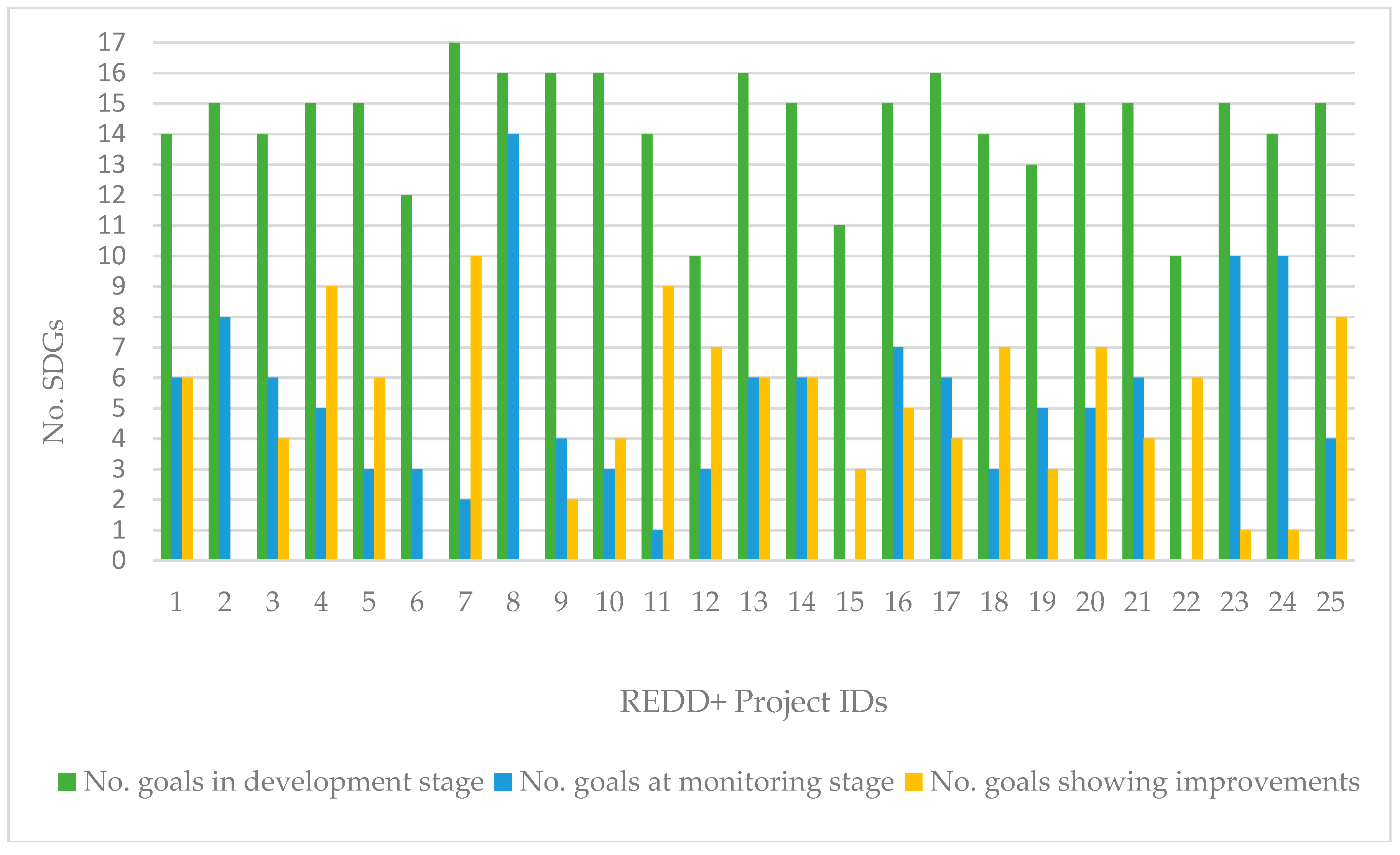
References
- Kosoy, N.; Corbera, E. Payments for ecosystem services as commodity fetishism. Ecol. Econ. 2010, 69, 1228–1236. [Google Scholar] [CrossRef] [Green Version]
- Khadka, M.; Karki, S.; Karky, B.; Kotru, R.; Darjee, K. Gender equality challenges to the REDD+ initiative in Nepal. Mt. Res. Dev. 2014, 34, 197–207. [Google Scholar] [CrossRef]
- Parrotta, J.; Wildburger, C.; Mansourian, S. Understanding Relationships between Biodiversity, Carbon, Forests and People: The Key to Achieving REDD+ Objectives. A Global Assessment Report Prepared by the Global Forest Expert Panel on Biodiversity, Forest Management, and REDD+; International Union of Forest Research Organizations (IUFRO): Vienna, Austria, 2012; pp. 1–161. [Google Scholar]
- UN-REDD. Safeguards—UN-REDD Programme Collaborative Online Workspace. Available online: https://www.unredd.net/knowledge/redd-plus-technical-issues/safeguards.html (accessed on 15 August 2018).
- Schroeder, H.; McDermott, C. Beyond carbon: Enabling justice and equity in REDD+ across levels of governance. Ecol. Soc. 2014, 19. [Google Scholar] [CrossRef]
- Sikor, T.; Cầm, H. REDD+ on the rocks? Conflict over forest and politics of justice in Vietnam. Hum. Ecol. 2016, 44, 217–227. [Google Scholar] [CrossRef] [PubMed] [Green Version]
- United Nations. Framework Convention on Climate Change. Available online: http://unfccc.int/resource/docs/2010/cop16/eng/07a01.pdf (accessed on 15 August 2018).
- Clements, T. Reduced expectations: The political and institutional challenges of REDD+. Oryx 2010, 44, 309–310. [Google Scholar] [CrossRef]
- Food and Agriculture Organization of the United Nations (FAO). The State of the World’s Forests 2018—Forest Pathways to Sustainable Development; FAO: Rome, Italy, 2018. [Google Scholar]
- Panfil, S.; Harvey, C. REDD+ and Biodiversity Conservation: Approaches, Experiences and Opportunities for Improved Outcomes; USAID-supported Forest Carbon, Markets and Communities (FCMC) Program: Washington, DC, USA, 2014. [Google Scholar]
- Paladino, S.; Fiske, S. The Carbon Fix: Forest Carbon, Social Justice, and Environmental Governance; Routledge: Abingdon, UK, 2017. [Google Scholar]
- Richards, M.; Panfil, S.N. Social and Biodiversity Impact Assessment (SBIA) Manual for REDD+ Projects: Part 1—Core Guidance for Project Proponents; Climate, Community & Biodiversity Alliance, Forest Trends, Fauna & Flora International, and Rainforest Alliance: Washington, DC, USA, 2011. [Google Scholar]
- Verified Carbon Standard. VCS Project Database. Available online: http://www.vcsprojectdatabase.org/#/ccb-verified (accessed on 15 August 2018).
- Cadman, T.; Maraseni, T.; Ma, H.O.; Lopez-Casero, F. Five years of REDD+ governance: The use of market mechanisms as a response to anthropogenic climate change. For. Policy Econ. 2017, 79, 8–16. [Google Scholar] [CrossRef]
- Myers, R.; Larson, A.M.; Ravikumar, A.; Fowler, L.F.; Yang, A.; Trench, T. Messiness of forest governance: How technical approaches suppress politics in REDD+ and conservation projects. Glob. Environ. Chang. 2018, 50, 314–324. [Google Scholar] [CrossRef]
- United Nations. The Sustainable Development Goals and Targets. Available online: http://17goals.org/wp-content/uploads/2017/04/SDGs_17Goals_StudyEdition_v2b.pdf (accessed on 15 August 2018).
- Stafford-Smith, M. UN sustainability goals need quantified targets. Nature 2014, 513, 281. [Google Scholar] [CrossRef] [PubMed]
- Stokstad, E. Sustainable goals from UN under fire. Science 2015, 347, 702–703. [Google Scholar] [CrossRef] [PubMed]
- Waage, J.; Yap, C.; Bell, S.; Levy, C.; Mace, G.; Pegram, T.; Unterhalter, E.; Dasandi, N.; Hudson, D.; Kock, R.; et al. Governing the UN Sustainable Development Goals: Interactions, infrastructures, and institutions. Lancet Glob. Health 2015, 3, e251–e252. [Google Scholar] [CrossRef]
- Timko, J.; Le Billon, P.; Zerriffi, H.; Honey-Rosés, J.; de la Roche, I.; Gaston, C.; Sunderland, T.; Kozak, R. A policy nexus approach to forests and the SDGS: tradeoffs and synergies. Curr. Opin. Environ. Sustain. 2018, 34, 7–12. [Google Scholar] [CrossRef]
- UN-REDD. Fact Sheet 1: About REDD3. (ebook). 2016. Available online: https://www.unredd.net/documents/redd-papers-and-publications-90/un-redd-publications-1191/fact-sheets/15279-fact-sheet-about-redd.html?path=redd-papers-and-publications-90/un-redd-publications-1191/fact-sheets (accessed on 15 August 2018).
- InfiniteEARTH. Rimba Raya Initiatives and Matching UN SDGs, 2016. Available online: http://rimba-raya.com/wp-content/uploads/Rimba-Raya-Initiatives-UN-SDGs-2016.pdf (accessed on 15 August 2018).
- Schreckenberg, K.; Camargo, I.; Withnall, K.; Corrigan, C.; Franks, P.; Roe, D.; Scherl, L.M.; Richardson, V. Social Assessment of Conservation Initiatives: A Review of Rapid Methodologies; Natural Resource Issues: London, UK, 2010. [Google Scholar]
- Isyaku, U.; Arhin, A.; Asiyanbi, A. Framing justice in REDD+ governance: Centring transparency, equity and legitimacy in readiness implementation in West Africa. Environ. Conserv. 2017, 44, 212–220. [Google Scholar] [CrossRef]
- Panfil, S.; Harvey, C. REDD+ and biodiversity conservation: A review of the biodiversity goals, monitoring methods, and impacts of 80 REDD+ projects. Conserv. Lett. 2015, 9, 143–150. [Google Scholar] [CrossRef]
- Climate, Community and Biodiversity Alliance (CCBA). Climate, Community and Biodiversity Project Design Standards, 1st ed.; CCBA: Washington, DC, USA, 2005. [Google Scholar]
- Climate, Community and Biodiversity Alliance (CCBA). Climate, Community and Biodiversity Project Design Standards, 2nd ed.; CCBA: Arlington, VA, USA, 2008. [Google Scholar]
- Climate, Community and Biodiversity Alliance (CCBA). Climate, Community and Biodiversity Standards, 3rd ed.; CCBA: Arlington, VA, USA, 2013. [Google Scholar]
- Pahuja, N.; Rai, A. SDG Footprint of Asian NDCs: Exploring Synergies between Domestic Policies and International Goals; The Energy and Resources Institute: New Delhi, India, 2017. [Google Scholar]
- Kapos, V.; Balmford, A.; Aveling, R.; Bubb, P.; Carey, P.; Entwistle, A.; Hopkins, J.; Mulliken, T.; Safford, R.; Stattersfield, A.; et al. Outcomes, not implementation, predict conservation success. Oryx 2009, 43, 336–342. [Google Scholar] [CrossRef]
- Organisation for Economic Cooperation and Development (OECD). Measuring and Managing Results in Development Co-Operation: A Review of Challenges and Practices among DAC Members and Observers; OECD: Paris, French, 2014. [Google Scholar]
- Flora & Fauna International Conservation Report 2014–2015—Based on 2014 Annual Reports. Flora & Fauna International: Cambridge, UK, 2015. Available online: http://www.fauna-flora.org/wp-content/uploads/Conservation-Report-2014-2015_final.pdf (accessed on 15 August 2018).
- Visseren-Hamakers, I.; Gupta, A.; Herold, M.; Peña-Claros, M.; Vijge, M. Will REDD+ work? The need for interdisciplinary research to address key challenges. Curr. Opin. Environ. Sustain. 2012, 4, 590–596. [Google Scholar] [CrossRef]
- Climate, Community and Biodiversity Alliance. CCB & VCS Monitoring Report Template 3.0, 2017. Available online: http://verra.org/project/vcs-program/rules-and-requirements/ (accessed on 20 September 2018).
- Climate, Community and Biodiversity Alliance. CCB & VCS Monitoring Report Template 2.0, 2017. Available online: http://verra.org/project/vcs-program/rules-and-requirements/ (accessed on 20 September 2018).
- Margoluis, R.A.; Salafsky, N. Measures of Success: Designing, Managing and Monitoring Conservation and Development Projects; Island Press: Washington, DC, USA, 1998. [Google Scholar]

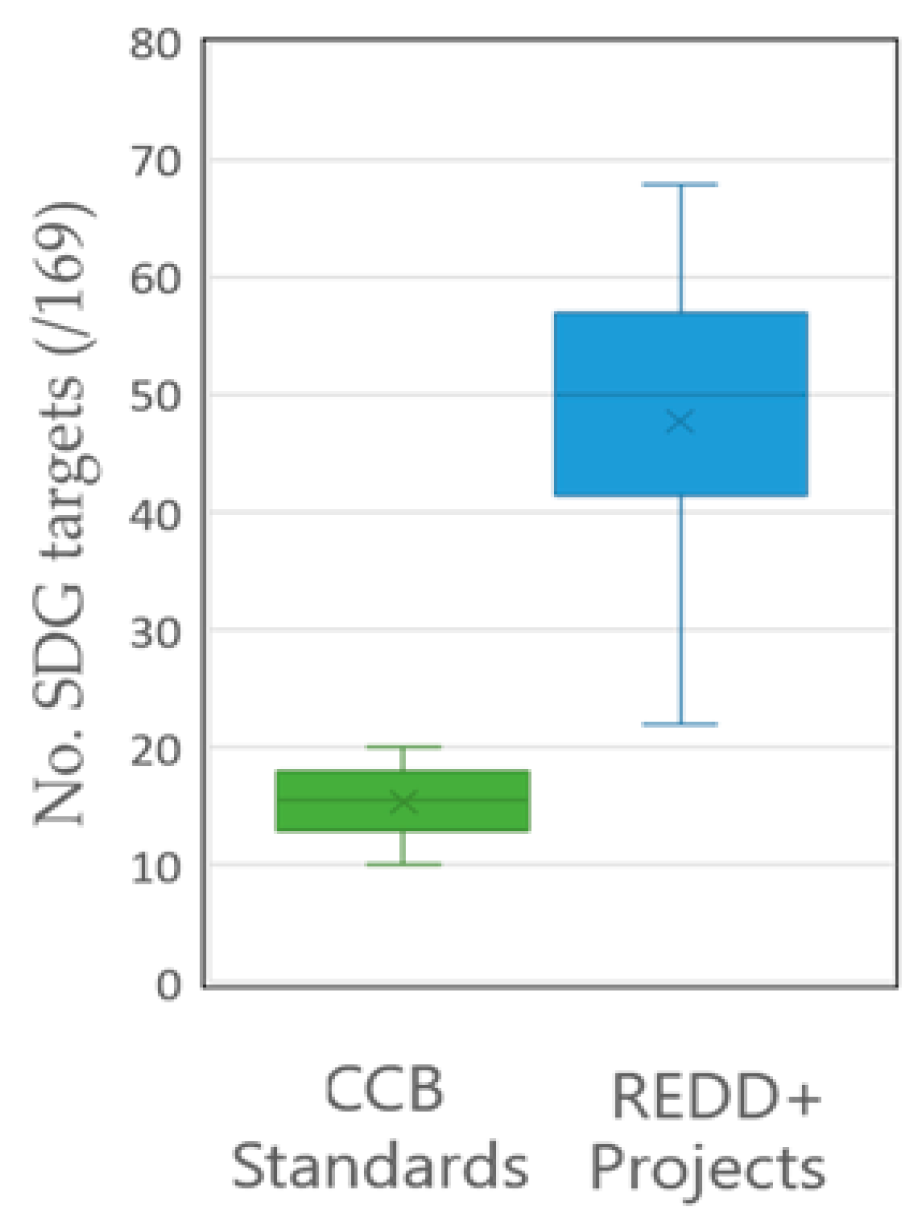
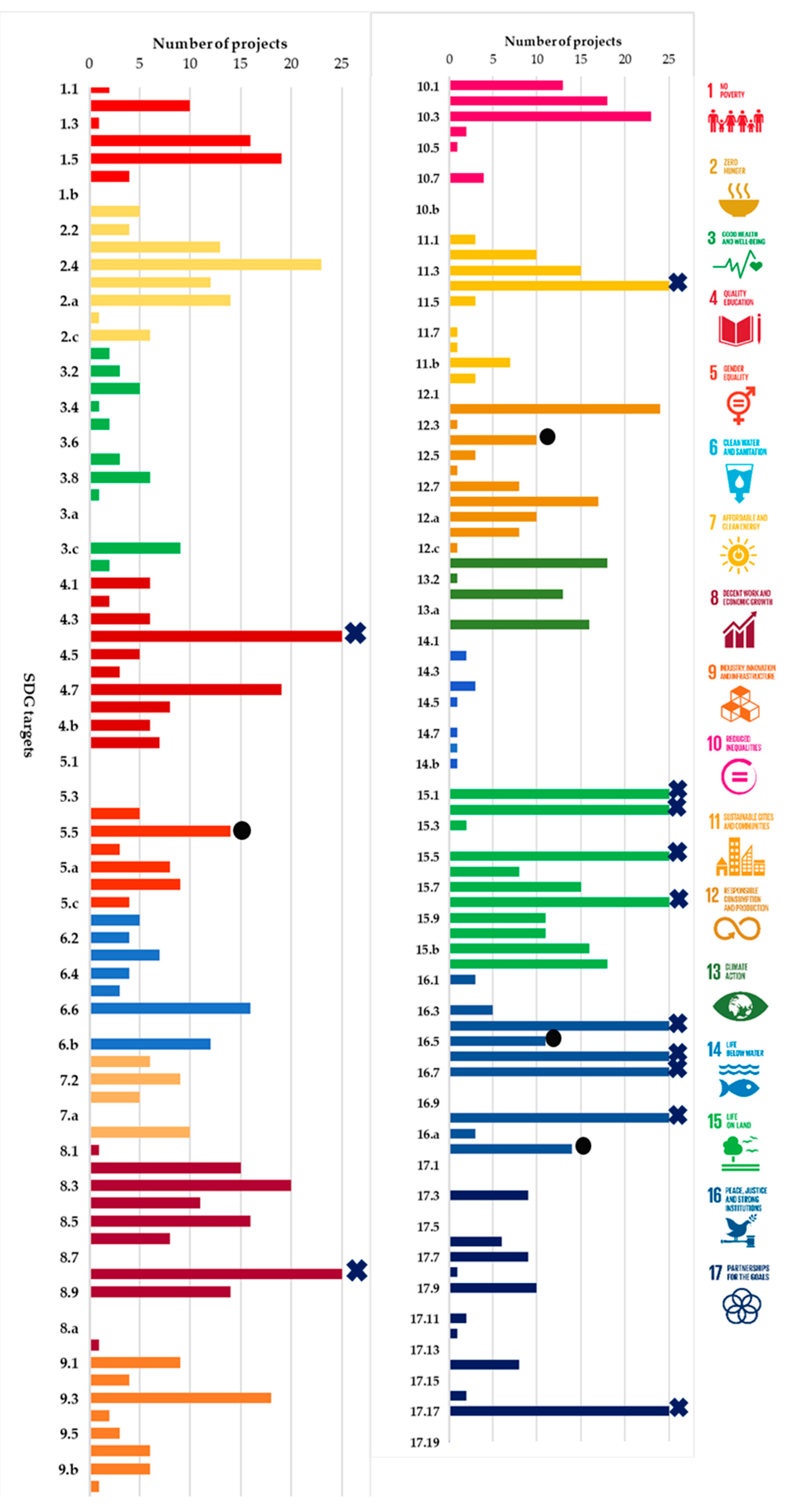
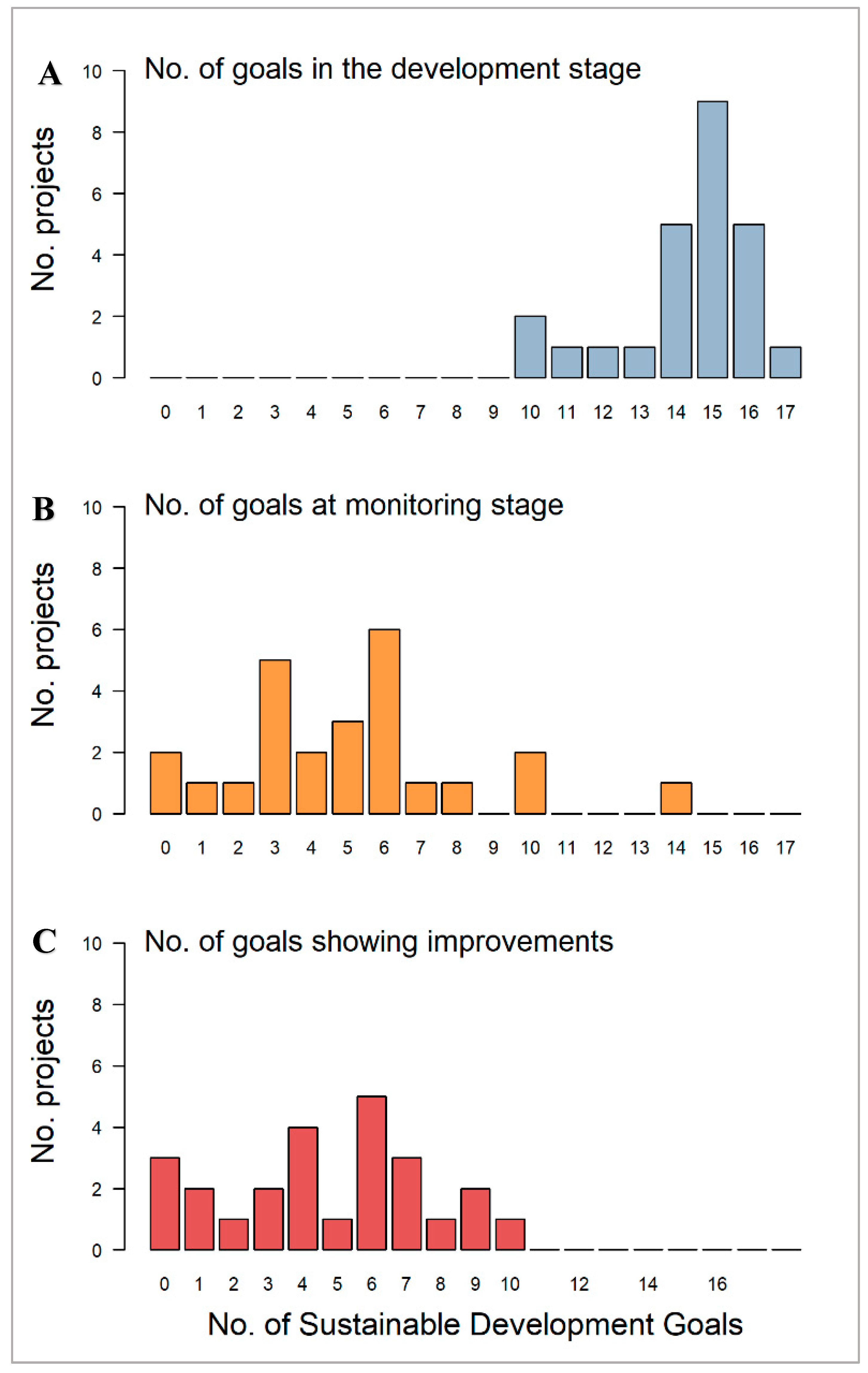
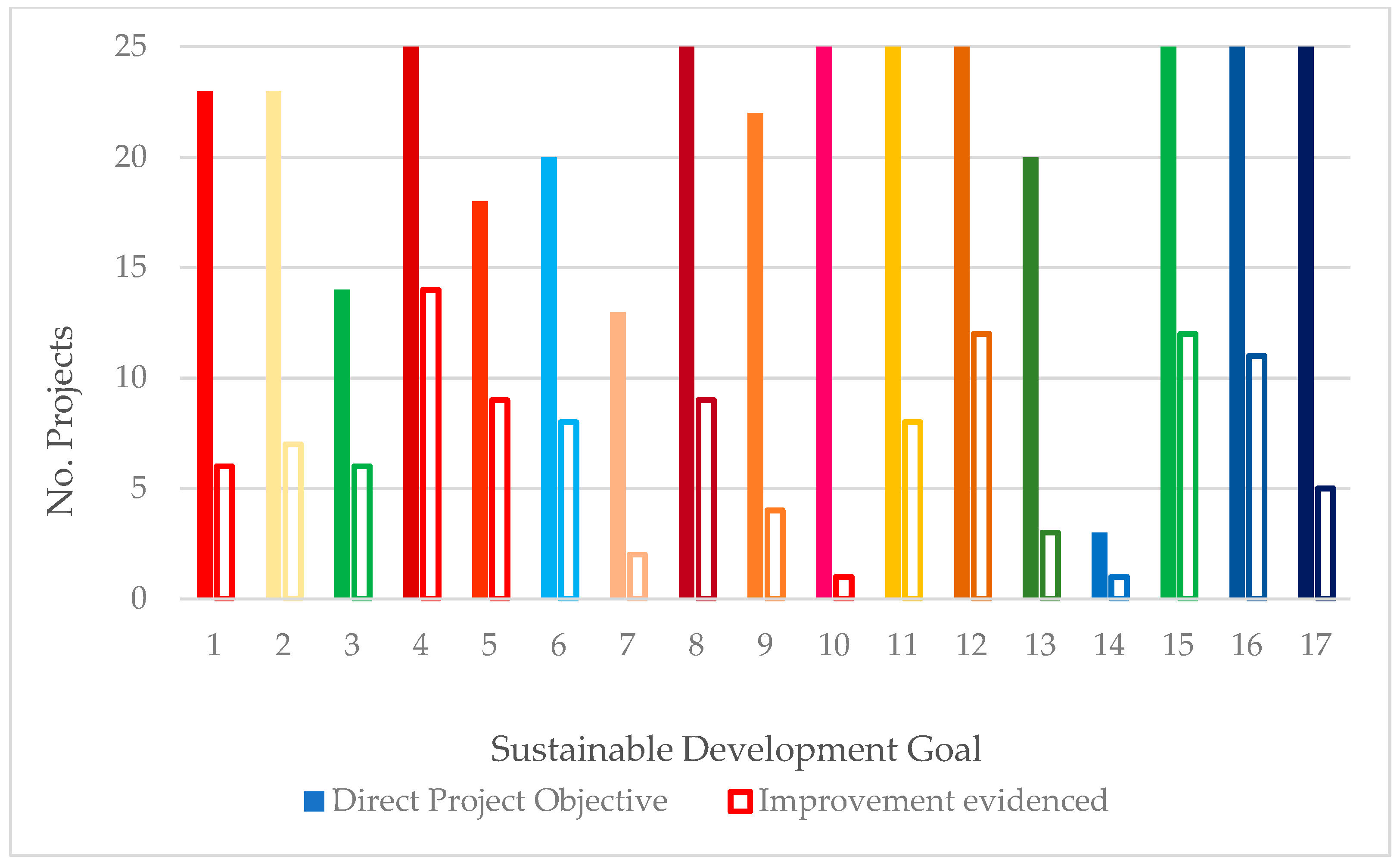
| Total Verified Carbon Standard Projects | 1441 |
| Total Climate, Community and Biodiversity Alliance (CCB) Projects (All Types) | 94 |
| Total CCB REDD+ Projects | 75 |
| Total CCB–REDD+ Projects (Verified) | 30 |
| Total CCB REDD+ Projects (Verified, English Project Design Document and English Project Implementation Report) | 25 |
| Total REDD+ Projects Reviewed | 25 |
| Sustainable Development Goal | Impact Stage | Example Monitoring Metrics | |||
|---|---|---|---|---|---|
| 0 | 1 | 2 | 3 | ||
 | 0 | 6 | 13 | 6 | No. of people with improved livelihoods or income resulting from the project |
 | 2 | 4 | 12 | 7 | No. of people adopting improved agricultural practices. |
 | 10 | 4 | 5 | 6 | Mortality rates; incidence of diarrhea, typhoid. |
 | 0 | 5 | 6 | 14 | No. of children attending school; literacy rates of family members. |
 | 6 | 5 | 5 | 9 | % women on community councils; no. women employed. |
 | 4 | 9 | 4 | 8 | No. of hectares of water source protected; % latrine access. |
 | 8 | 8 | 7 | 2 | No. of households/individuals accessing renewable energy. |
 | 1 | 4 | 11 | 9 | No. of villagers trained and contracted by the project. |
 | 5 | 8 | 8 | 4 | No. of individuals with new knowledge/skills in business administration/value-added processing. |
 | 4 | 13 | 7 | 1 | Income/asset inequality; most disadvantaged communities. |
 | 1 | 8 | 8 | 8 | Mapping of cultural identity areas; no. of households with upgraded roof materials. |
 | 0 | 6 | 7 | 12 | No. of rubbish collection days/year; no. of ecotourism sites established. |
 | 7 | 12 | 3 | 3 | No. of beneficiaries of conservation agriculture. |
 | 21 | 1 | 2 | 1 | No. of fishing restriction zones established. |
 | 0 | 0 | 13 | 12 | % change in ha better managed by the project for biodiversity; presence of endangered species |
 | 0 | 5 | 9 | 11 | No. of grievances; no. of illegal activities recorded |
 | 1 | 13 | 6 | 5 | No. of public-private partnerships agreed. |
© 2018 by the authors. Licensee MDPI, Basel, Switzerland. This article is an open access article distributed under the terms and conditions of the Creative Commons Attribution (CC BY) license (http://creativecommons.org/licenses/by/4.0/).
Share and Cite
Milbank, C.; Coomes, D.; Vira, B. Assessing the Progress of REDD+ Projects towards the Sustainable Development Goals. Forests 2018, 9, 589. https://doi.org/10.3390/f9100589
Milbank C, Coomes D, Vira B. Assessing the Progress of REDD+ Projects towards the Sustainable Development Goals. Forests. 2018; 9(10):589. https://doi.org/10.3390/f9100589
Chicago/Turabian StyleMilbank, Charlotte, David Coomes, and Bhaskar Vira. 2018. "Assessing the Progress of REDD+ Projects towards the Sustainable Development Goals" Forests 9, no. 10: 589. https://doi.org/10.3390/f9100589
APA StyleMilbank, C., Coomes, D., & Vira, B. (2018). Assessing the Progress of REDD+ Projects towards the Sustainable Development Goals. Forests, 9(10), 589. https://doi.org/10.3390/f9100589





